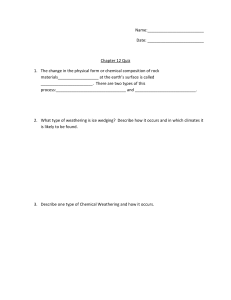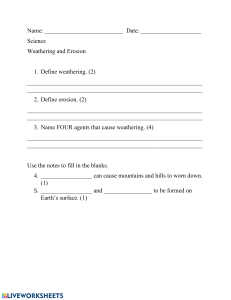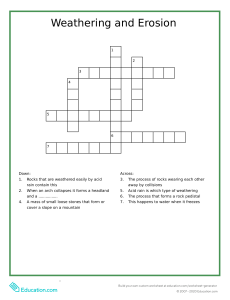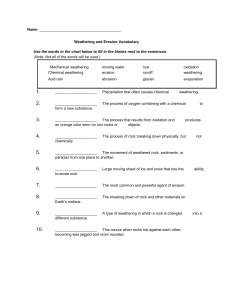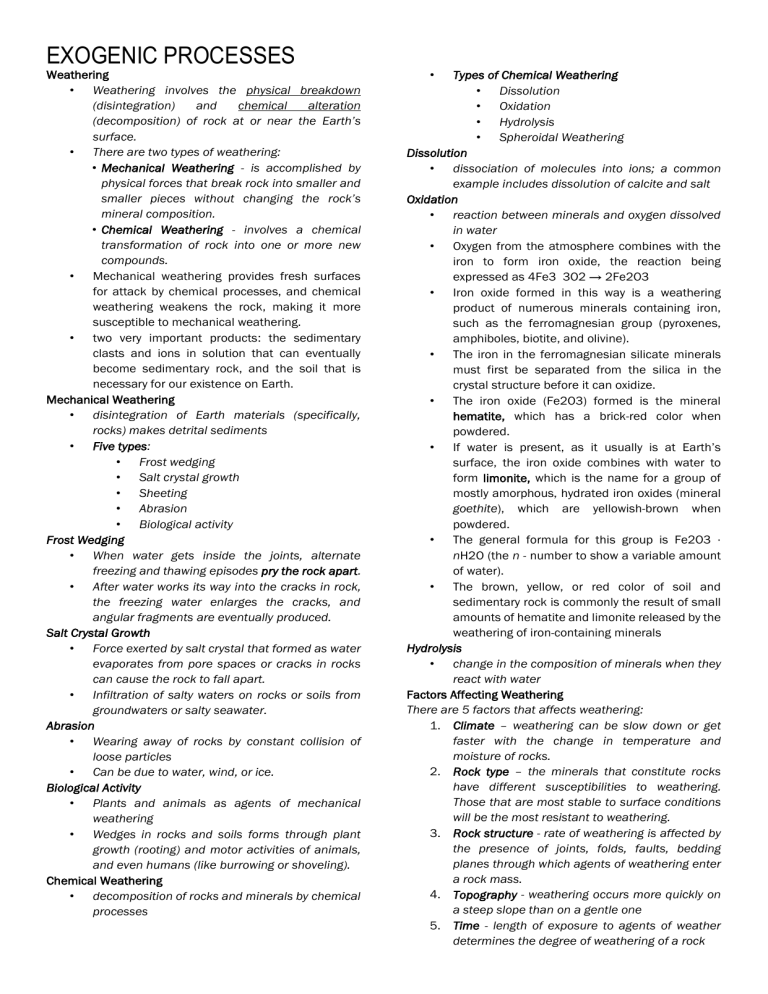
EXOGENIC PROCESSES Weathering • Weathering involves the physical breakdown (disintegration) and chemical alteration (decomposition) of rock at or near the Earth’s surface. • There are two types of weathering: • Mechanical Weathering - is accomplished by physical forces that break rock into smaller and smaller pieces without changing the rock’s mineral composition. • Chemical Weathering - involves a chemical transformation of rock into one or more new compounds. • Mechanical weathering provides fresh surfaces for attack by chemical processes, and chemical weathering weakens the rock, making it more susceptible to mechanical weathering. • two very important products: the sedimentary clasts and ions in solution that can eventually become sedimentary rock, and the soil that is necessary for our existence on Earth. Mechanical Weathering • disintegration of Earth materials (specifically, rocks) makes detrital sediments • Five types: • Frost wedging • Salt crystal growth • Sheeting • Abrasion • Biological activity Frost Wedging • When water gets inside the joints, alternate freezing and thawing episodes pry the rock apart. • After water works its way into the cracks in rock, the freezing water enlarges the cracks, and angular fragments are eventually produced. Salt Crystal Growth • Force exerted by salt crystal that formed as water evaporates from pore spaces or cracks in rocks can cause the rock to fall apart. • Infiltration of salty waters on rocks or soils from groundwaters or salty seawater. Abrasion • Wearing away of rocks by constant collision of loose particles • Can be due to water, wind, or ice. Biological Activity • Plants and animals as agents of mechanical weathering • Wedges in rocks and soils forms through plant growth (rooting) and motor activities of animals, and even humans (like burrowing or shoveling). Chemical Weathering • decomposition of rocks and minerals by chemical processes Types of Chemical Weathering • Dissolution • Oxidation • Hydrolysis • Spheroidal Weathering Dissolution • dissociation of molecules into ions; a common example includes dissolution of calcite and salt Oxidation • reaction between minerals and oxygen dissolved in water • Oxygen from the atmosphere combines with the iron to form iron oxide, the reaction being expressed as 4Fe3 3O2 → 2Fe2O3 • Iron oxide formed in this way is a weathering product of numerous minerals containing iron, such as the ferromagnesian group (pyroxenes, amphiboles, biotite, and olivine). • The iron in the ferromagnesian silicate minerals must first be separated from the silica in the crystal structure before it can oxidize. • The iron oxide (Fe2O3) formed is the mineral hematite, which has a brick-red color when powdered. • If water is present, as it usually is at Earth’s surface, the iron oxide combines with water to form limonite, which is the name for a group of mostly amorphous, hydrated iron oxides (mineral goethite), which are yellowish-brown when powdered. • The general formula for this group is Fe2O3 ⋅ nH2O (the n - number to show a variable amount of water). • The brown, yellow, or red color of soil and sedimentary rock is commonly the result of small amounts of hematite and limonite released by the weathering of iron-containing minerals Hydrolysis • change in the composition of minerals when they react with water Factors Affecting Weathering There are 5 factors that affects weathering: 1. Climate – weathering can be slow down or get faster with the change in temperature and moisture of rocks. 2. Rock type – the minerals that constitute rocks have different susceptibilities to weathering. Those that are most stable to surface conditions will be the most resistant to weathering. 3. Rock structure - rate of weathering is affected by the presence of joints, folds, faults, bedding planes through which agents of weathering enter a rock mass. 4. Topography - weathering occurs more quickly on a steep slope than on a gentle one 5. Time - length of exposure to agents of weather determines the degree of weathering of a rock • EXOGENIC PROCESSES Factor Climate: Cold and dry = slow rate of chemical weathering High temperature and high rainfall = high rate of chemical weathering Rock Type: Weathering rates roughly follow the inverse of the order of crystallization of minerals in the Bowen’s reaction series Rock Structure: The presence of cracks where agents of weathering (water, plant roots, etc.) can enter enhances weathering Topography: Physical weathering occurs more quickly on a steep slope than on a gentle one Time: Longer time of exposure to agents weathering means higher rate of weathering. How does it affect weathering? If you go back to the chemical processes, most if not weathering all are chemical reactions involving water. Hence, the presence of water which is an important chemical weathering agent increases the rate of weathering. High temperature enhances chemical reactions. Recall that temperature is an important factor of mineral formation/crystallization. Olivine crystalizes at high temperature while quartz at the lowest temperature as compared to the other minerals. Therefore, quartz is the most stable on surface conditions (low temperature conditions), while the other minerals in the series would be less stable. Olivine would be least stable. Limestone however will have a high susceptibility to weathering even though it is formed at surface temperature, because it can be easily dissolved by water (cite Bohol chocolate hills for example). These cracks/structures facilitate the entry of weathering agents. Be careful on this because this is a very tricky factor. Physical weathering occurs faster when the slope is steep due to the higher slope’s susceptibility to mass wasting and the higher rate at which new materials are exposed to agents of mass wasting (rainwater can easily wash away weathered materials downslope). However, in gentle slopes, the rate of chemical weathering may be higher. This is due to the fact that water which is an agent of weathering may stay longer in the gentle slopes. Longer time of exposure to weathering agents could mean higher degree of weathering processes have occurred. The rock has been weakened, therefore easier to be break.
